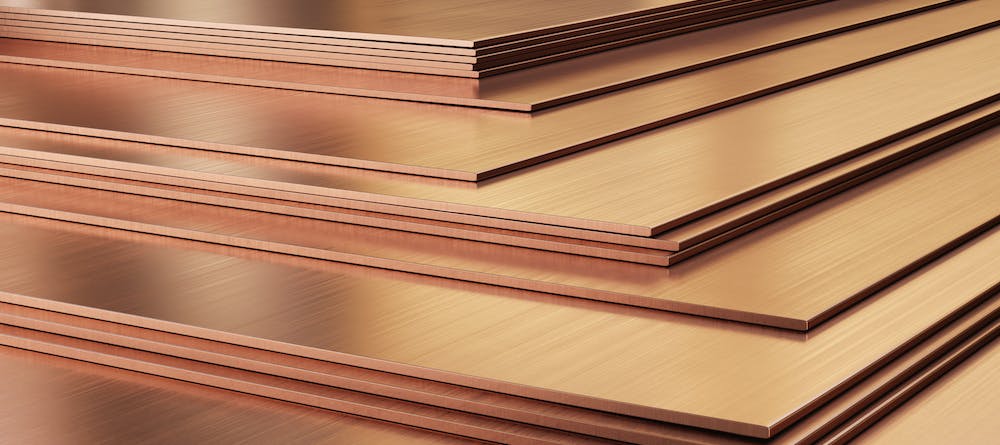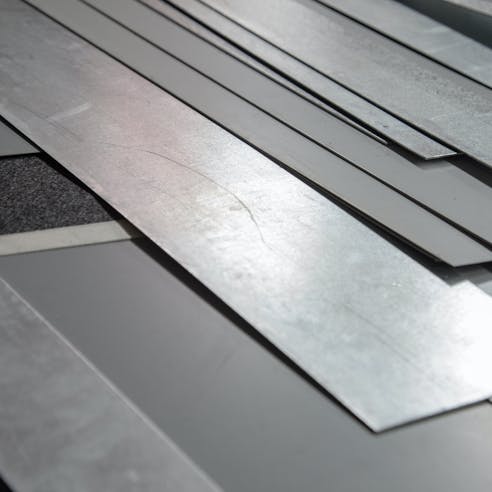Copper Sheet Metal Fabrication
Upload your CAD files to get an instant online copper fabrication quote. Lead times as fast as days and free standard shipping on all US orders.

About Copper Sheet Metal Fabrication
Commercial copper sheet metal has high purity ratings and is generally supplied in two variants. Both of these variants consist of more than 99% copper with the remainder being impurities like oxygen, lead, or silver. It is highly formable, making the use of copper for sheet metal applications easier than other less ductile materials.
Copper has excellent thermal and electrical conductivity and is highly formable, making it an outstanding material for sheet metal applications. Because of these properties, industries like the aerospace, automotive, and chemical processing regularly use copper for sheet metal fabrication.
Copper 101
Copper 101, or oxygen-free copper is a highly pure form of metal (99.99% Cu). This high purity gives it exceptional conductivity, so it is often referred to as HC (high conductivity) copper. It is highly ductile and though it tends to work-harden, it does so at a slow rate. C101 can be annealed to make it easier to form. This high degree of conductivity and ductility make it ideal for electrical sheet metal applications like grounding strips, anodes, and circuit breakers.
| Tensile Strength, Yield (MPa) | Fatigue Strength (MPa) | Elongation at Break (%) | Hardness (Brinell) | Density (g/cm^3) |
|---|---|---|---|---|
Tensile Strength, Yield (MPa) 69 | Fatigue Strength (MPa) 90 | Elongation at Break (%) 55 | Hardness (Brinell) 81 | Density (g/cm^3) 8.9 |
| Material | Standard Sheet Thickness |
|---|---|
Material Copper 101, H00 to H01 | Standard Sheet Thickness 0.025”, 0.032”, 0.040”, 0.050”, 0.063” |
Copper C110
Copper 110, or ETP Copper (Electrolytic Tough Pitch), is another highly pure metal. However, at 99.90% Cu, it is not as pure as copper 101. It is also the most commercially available copper alloy and is used primarily in electrical and thermal transfer applications such as heat exchanger fins and electrical switches.
| Tensile Strength, Yield (MPa) | Fatigue Strength (MPa) | Elongation at Break (%) | Hardness (Brinell) | Density (g/cm^3) |
|---|---|---|---|---|
Tensile Strength, Yield (MPa) 365 | Fatigue Strength (MPa) 76 | Elongation at Break (%) 55 | Hardness (Brinell) 57 | Density (g/cm^3) 8.93 |
| Material | Standard Sheet Thickness |
|---|---|
Material Copper 110, Annealed | Standard Sheet Thickness 0.005”, 0.010”, 0.021”, 0.043”, 0.063”, 0.093”, 0.125” |
Material Copper 110, H01 | Standard Sheet Thickness 0.016” |
Material Copper 110, H02 | Standard Sheet Thickness 0.020”, 0.040”, 0.050”, 0.063”, 0.080”, 0.093”, 0.125”, 0.188”, 0.250” |
Finishes
In general, copper material properties, such as, its thermal and electrical conductivity, makes copper a good use for sheet metal fabrication. Many common surface finishes used on other materials would not be suitable in this case because they would hinder these properties. Listed below are some applicable surface finishes for copper.
Electropolishing: Copper can be electropolished to achieve an extremely smooth and shiny surface. This process removes a minuscule amount of material from the surface — typically between 0.0001” and 0.0025” worth. The resulting smooth surface can further improve the corrosion resistance of sheet metal parts.
Lacquering: Copper tends to oxidize when exposed to the elements. This oxidation process creates a green layer on the surface. If the sheet metal part is purely cosmetic in nature it can be coated with a lacquer or clear coat to maintain the original look even when exposed to corrosive environments. It must be noted, however, that this coating will typically eliminate the parts’ electrical properties and hamper thermal conductivity.

Cost-saving Design Tips
Copper is a costly material, so the use of Copper for sheet metal fabrication should be optimized as much as possible.
Only use where required: If possible, only use copper for sheet metal fabrication where necessary. Manufacturing an entire part out of copper sheet will be prohibitively expensive if only a small portion of the part needs the material’s properties. It may be better to bolt or braze copper sheet metal parts where required and use a low-cost material for areas that don’t need high thermal or electrical conductivity.
Choose the right grade: Ultra-pure copper is typically used for electrical applications due to its high conductivity. As such, it’s best to only use this version in situations that specifically need to transfer electricity efficiently. Grounding strips and circuit breakers, for example, need very pure metal. Lower-purity copper may be better suited to applications that don’t need quite that level of efficiency.
